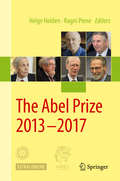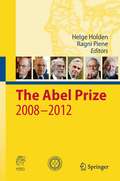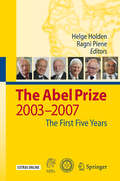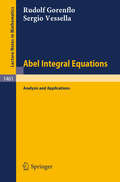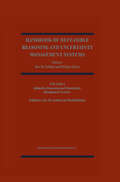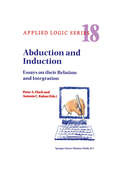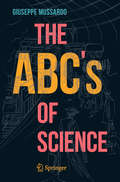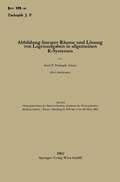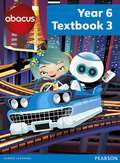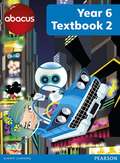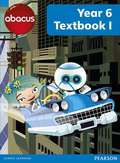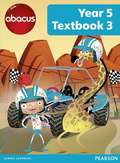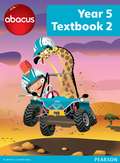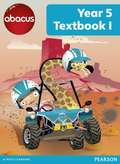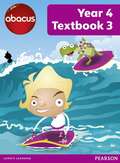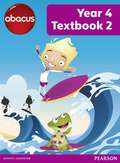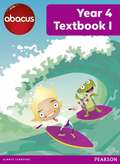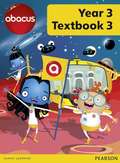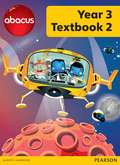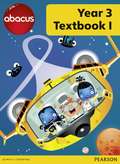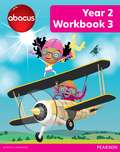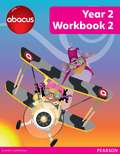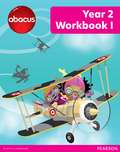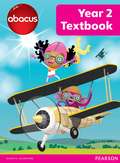- Table View
- List View
The Abel Prize 2013-2017 (The Abel Prize)
by Helge Holden Ragni PieneThe book presents the winners of the Abel Prize in mathematics for the period 2013–17: Pierre Deligne (2013); Yakov G. Sinai (2014); John Nash Jr. and Louis Nirenberg (2015); Sir Andrew Wiles (2016); and Yves Meyer (2017). The profiles feature autobiographical information as well as a scholarly description of each mathematician’s work. In addition, each profile contains a Curriculum Vitae, a complete bibliography, and the full citation from the prize committee. The book also includes photos for the period 2003–2017 showing many of the additional activities connected with the Abel Prize. As an added feature, video interviews with the Laureates as well as videos from the prize ceremony are provided at an accompanying website (http://extras.springer.com/). This book follows on The Abel Prize: 2003-2007. The First Five Years (Springer, 2010) and The Abel Prize 2008-2012 (Springer 2014), which profile the work of the previous Abel Prize winners.
The Abel Prize 2008-2012 (The Abel Prize)
by Helge Holden Ragni PieneCovering the years 2008-2012, this book profiles the life and work of recent winners of the Abel Prize: · John G. Thompson and Jacques Tits, 2008· Mikhail Gromov, 2009· John T. Tate Jr., 2010· John W. Milnor, 2011· Endre Szemerédi, 2012.The profiles feature autobiographical information as well as a description of each mathematician's work. In addition, each profile contains a complete bibliography, a curriculum vitae, as well as photos — old and new. As an added feature, interviews with the Laureates are presented on an accompanying web site (http://extras.springer.com/).The book also presents a history of the Abel Prize written by the historian Kim Helsvig, and includes a facsimile of a letter from Niels Henrik Abel, which is transcribed, translated into English, and placed into historical perspective by Christian Skau.This book follows on The Abel Prize: 2003-2007, The First Five Years (Springer, 2010), which profiles the work of the first Abel Prize winners.
The Abel Prize: 2003-2007 The First Five Years (The Abel Prize)
by Helge Holden Ragni PieneThe book presents the winners of the first five Abel Prizes in mathematics: 2003 Jean-Pierre Serre; 2004 Sir Michael Atiyah and Isadore Singer; 2005 Peter D. Lax; 2006 Lennart Carleson; and 2007 S.R. Srinivasa Varadhan. Each laureate provides an autobiography or an interview, a curriculum vitae, and a complete bibliography. This is complemented by a scholarly description of their work written by leading experts in the field and by a brief history of the Abel Prize. Interviews with the laureates can be found at http://extras.springer.com .
Abel Integral Equations: Analysis and Applications (Lecture Notes in Mathematics #1461)
by Rudolf Gorenflo Sergio VessellaIn many fields of application of mathematics, progress is crucially dependent on the good flow of information between (i) theoretical mathematicians looking for applications, (ii) mathematicians working in applications in need of theory, and (iii) scientists and engineers applying mathematical models and methods. The intention of this book is to stimulate this flow of information. In the first three chapters (accessible to third year students of mathematics and physics and to mathematically interested engineers) applications of Abel integral equations are surveyed broadly including determination of potentials, stereology, seismic travel times, spectroscopy, optical fibres. In subsequent chapters (requiring some background in functional analysis) mapping properties of Abel integral operators and their relation to other integral transforms in various function spaces are investi- gated, questions of existence and uniqueness of solutions of linear and nonlinear Abel integral equations are treated, and for equations of the first kind problems of ill-posedness are discussed. Finally, some numerical methods are described. In the theoretical parts, emphasis is put on the aspects relevant to applications.
Abductive Reasoning and Learning (Handbook of Defeasible Reasoning and Uncertainty Management Systems #4)
by Dov M. Gabbay Philippe SmetsThis book contains leading survey papers on the various aspects of Abduction, both logical and numerical approaches. Abduction is central to all areas of applied reasoning, including artificial intelligence, philosophy of science, machine learning, data mining and decision theory, as well as logic itself.
Abduction and Induction: Essays on their Relation and Integration (Applied Logic Series #18)
by P. A. Flach Antonis HadjiantonisFrom the very beginning of their investigation of human reasoning, philosophers have identified two other forms of reasoning, besides deduction, which we now call abduction and induction. Deduction is now fairly well understood, but abduction and induction have eluded a similar level of understanding. The papers collected here address the relationship between abduction and induction and their possible integration. The approach is sometimes philosophical, sometimes that of pure logic, and some papers adopt the more task-oriented approach of AI. The book will command the attention of philosophers, logicians, AI researchers and computer scientists in general.
The ABC’s of Science
by Giuseppe MussardoScience, with its inherent tension between the known and the unknown, is an inexhaustible mine of great stories. Collected here are twenty-six among the most enchanting tales, one for each letter of the alphabet: the main characters are scientists of the highest caliber most of whom, however, are unknown to the general public.This book goes from A to Z. The letter A stands for Abel, the great Norwegian mathematician, here involved in an elliptic thriller about a fundamental theorem of mathematics, while the letter Z refers to Absolute Zero, the ultimate and lowest temperature limit, - 273,15 degrees Celsius, a value that is tremendously cooler than the most remote corner of the Universe: the race to reach this final outpost of coldness is not yet complete, but, similarly to the history books of polar explorations at the beginning of the 20th century, its pages record successes, failures, fierce rivalries and tragic desperations. In between the A and the Z, the other letters of the alphabet are similar to the various stages of a very fascinating journey along the paths of science, a journey in the company of a very unique set of characters as eccentric and peculiar as those in Ulysses by James Joyce: the French astronomer who lost everything, even his mind, to chase the transits of Venus; the caustic Austrian scientist who, perfectly at ease with both the laws of psychoanalysis and quantum mechanics, revealed the hidden secrets of dreams and the periodic table of chemical elements; the young Indian astrophysicist who was the first to understand how a star dies, suffering the ferocious opposition of his mentor for this discovery. Or the Hungarian physicist who struggled with his melancholy in the shadows of the desert of Los Alamos; or the French scholar who was forced to hide her femininity behind a false identity so as to publish fundamental theorems on prime numbers. And so on and so forth.Twenty-six stories, which reveal the most authentic atmosphere of science and the lives of some of its main players: each story can be read in quite a short period of time -- basically the time it takes to get on and off the train between two metro stations. Largely independent from one another, these twenty-six stories make the book a harmonious polyphony of several voices: the reader can invent his/her own very personal order for the chapters simply by ordering the sequence of letters differently. For an elementary law of Mathematics, this can give rise to an astronomically large number of possible books -- all the same, but - then again - all different. This book is therefore the ideal companion for an infinite number of real or metaphoric journeys.
ABC's of Science
by Charles A. OliverThis books is about alpha, beta, and gamma. These are the first three letters of the Greek alphabet. <P> <P> This alphabet was the major method of written communication in ancient times, and is of course still used today. The Greek letters are also the most commonly used symbols in science. In all branches of science, we use symbols to represent ideas and definitions. Symbols serve to simplify communication and calculations—once you get used to them, that is.
Abbildung linearer Räume und Lösung on Lagenaufgaben in allgemeinen K-Systemen
by Josef Peter TschupikAbacus Year 6, Textbook 3 (PDF)
by Hilda Merttens Jennie KerwinAbacus is a unique maths toolkit for inspiring a love of maths and ensuring progression for every child. Written by an expert author team, it has been carefully crafted on a robust approach to creating inspired and confi dent young mathematicians.
Abacus Year 6, Textbook 2 (PDF)
by Hilda Merttens Jennie KerwinAbacus is a unique maths toolkit for inspiring a love of maths and ensuring progression for every child. Written by an expert author team, it has been carefully crafted on a robust approach to creating inspired and confi dent young mathematicians.
Abacus Year 6, Textbook 1 (PDF)
by Hilda Merttens Ruth Merttens Jennie KerwinhAbacus is a unique maths toolkit for inspiring a love of maths and ensuring progression for every child. Written by an expert author team, it has been carefully crafted on a robust approach to creating inspired and confi dent young mathematicians.
Abacus Year 5, Textbook 3 (PDF)
by Hilda Merttens Jennie KerwinAbacus is a unique maths toolkit for inspiring a love of maths and ensuring progression for every child. Written by an expert author team, it has been carefully crafted on a robust approach to creating inspired and confi dent young mathematicians.
Abacus Year 5, Textbook 2 (Abacus 2013)
by Hilda Merttens Jennie KerwinAbacus is a unique maths toolkit for inspiring a love of maths and ensuring progression for every child. Written by an expert author team, it has been carefully crafted on a robust approach to creating inspired and confi dent young mathematicians.
Abacus Year 5, Textbook 1 (PDF)
by Hilda Merttens Jennie KerwinAbacus is a unique maths toolkit for inspiring a love of maths and ensuring progression for every child. Written by an expert author team, it has been carefully crafted on a robust approach to creating inspired and confi dent young mathematicians.
Abacus Year 4, Textbook 3 (PDF)
by Hilda Mertenns Jennie Kerwin Ruth MerttensAbacus is a unique maths toolkit for inspiring a love of maths and ensuring progression for every child. Written by an expert author team, it has been carefully crafted on a robust approach to creating inspired and confi dent young mathematicians.
Abacus Year 4, Textbook 2 (PDF)
by Hilda Merttens Jennie Kerwin Ruth MerttensAbacus is a unique maths toolkit for inspiring a love of maths and ensuring progression for every child. Written by an expert author team, it has been carefully crafted on a robust approach to creating inspired and confi dent young mathematicians.
Abacus Year 4, Textbook 1 (PDF)
by Hilda Merttens Jennie Kerwin Ruth MerttensAbacus is a unique maths toolkit for inspiring a love of maths and ensuring progression for every child. Written by an expert author team, it has been carefully crafted on a robust approach to creating inspired and confi dent young mathematicians.
Abacus Year 3, Textbook 3 (PDF)
by Hilda Mertenns Jennie Kerwin Ruth MerttensAbacus is a unique maths toolkit for inspiring a love of maths and ensuring progression for every child. Written by an expert author team, it has been carefully crafted on a robust approach to creating inspired and confi dent young mathematicians.
Abacus Year 3, Textbook 2 (Abacus 2013)
by Ruth MerttensAbacus is a unique maths toolkit for inspiring a love of maths and ensuring progression for every child. Written by an expert author team, it has been carefully crafted on a robust approach to creating inspired and confi dent young mathematicians.
Abacus Year 3, Textbook 1 (PDF)
by Hilda Merttens Jennie Kerwin Ruth MerttensPart of the Abacus toolkit, the textbooks provide: the perfect balance of practice and problem-solving for each area of maths pictorial representations to support children's conceptual understanding clearly laid out questions with instructions that are easy to follow a self-assessment opportunity on every page colour to indicate the different maths areas within the programme.
Abacus Year 2 Workbook 3 (Abacus 2013)
by Ruth MerttensPart of the Abacus toolkit, the workbooks provide: easy instructions for a teacher to explain to children an 'Action' to make the activity more practical a 'Think' to provide extra challenge a self-assessment opportunity on every page colour to indicate the different maths areas within the programme. Series Editor: Ruth Merttens Authors: Jennie Kerwin and Hilda Mertten
Abacus Year 2 Workbook 2 (Abacus 2013)
by Ruth MerttensPart of the Abacus toolkit, the workbooks provide: easy instructions for a teacher to explain to children an 'Action' to make the activity more practical a 'Think' to provide extra challenge a self-assessment opportunity on every page colour to indicate the different maths areas within the programme. Series Editor: Ruth Merttens Authors: Jennie Kerwin and Hilda Mertten.
Abacus Year 2 Workbook 1 (Abacus 2013)
by Ruth MerttensPart of the Abacus toolkit, the workbooks provide: easy instructions for a teacher to explain to children an 'Action' to make the activity more practical a 'Think' to provide extra challenge a self-assessment opportunity on every page colour to indicate the different maths areas within the programme. Series Editor: Ruth Merttens Authors: Jennie Kerwin and Hilda Mertten
Abacus Year 2 Textbook (Abacus 2013)
by Ruth MerttensPart of the Abacus toolkit, the textbooks provide: the perfect balance of practice and problem-solving for each area of maths pictorial representations to support children's conceptual understanding clearly laid out questions with instructions that are easy to follow a self-assessment opportunity on every page colour to indicate the different maths areas within the programme. Series Editor: Ruth Merttens Authors: Jennie Kerwin and Hilda Merttens
